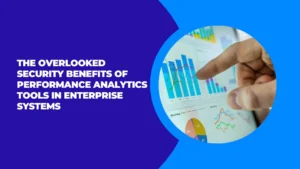Physical Address
304 North Cardinal St.
Dorchester Center, MA 02124
Physical Address
304 North Cardinal St.
Dorchester Center, MA 02124

In the fast-evolving landscape of enterprise technology, performance analytics tools are traditionally viewed as solutions for boosting operational efficiency, enhancing reporting, and driving smarter business decisions. But there’s a hidden layer of value often ignored by most businesses: cybersecurity benefits.
As cyber threats become increasingly sophisticated and unpredictable, organizations need to reevaluate the role of analytics, not just as a business intelligence asset, but also as a proactive security measure.
This shift in perspective is timely. Enterprises are now handling unprecedented volumes of data and user access points, making traditional perimeter-based security models obsolete.
What’s needed is deeper visibility, real-time insight into patterns, anomalies, and inefficiencies that could expose the business to internal or external threats. This is where performance analytics platforms step into the cybersecurity conversation.
Performance analytics tools collect and analyze data across departments, such as finance, sales, inventory, manufacturing, and more. While their main objective is to optimize workflows and financial performance, this data can also serve as a goldmine for detecting unusual activity.
For example, suppose a sales manager’s account starts accessing inventory data during odd hours or performs bulk downloads not typical of their workflow. Without analytics, these actions might go unnoticed. But with a performance analytics platform monitoring behavior patterns, deviations can trigger alerts or warrant investigation.
It’s this behavioral monitoring, intentional or not, that aligns performance analytics with cybersecurity. Just as SIEM (Security Information and Event Management) platforms analyze log data to detect threats, analytics platforms can flag inconsistencies in performance and usage trends that may indicate fraud, misuse, or even early signs of a breach.
Security isn’t only about stopping hackers; it’s about ensuring that data is accurate, consistent, and used properly. In regulated industries like healthcare, manufacturing, or financial services, data governance is not optional; it’s a mandate.
Performance analytics platforms enforce data integrity by centralizing information from disparate systems and providing a single source of truth. This centralization minimizes the risks of errors due to multiple data versions or conflicting reports. It also makes it easier to enforce role-based access controls, ensuring that sensitive data is only accessible to those who need it.
For example, some tools allow granular control over user access and visibility, ensuring employees only see the data relevant to their role. In a cybersecurity context, this not only reduces the surface area for data exposure but also improves compliance with frameworks like GDPR, HIPAA, or SOX.
One of the longstanding challenges in cybersecurity is the disconnect between IT and other departments. Security policies are often seen as disruptive or hard to understand, especially for teams focused on sales, operations, or finance. But when you introduce performance analytics into the mix, something interesting happens: the same tools used for tracking KPIs and revenue growth also begin to reveal behaviors that are security-relevant.
For instance, a spike in failed login attempts or a sudden drop in system performance tied to a specific data process could be viewed as just an IT issue. But seen through the lens of performance analytics, it becomes a cross-functional alert that could signal insider threats or data exfiltration attempts.
By democratizing data and making insights accessible to non-technical users, platforms can empower departments to take part in security hygiene. This creates a culture of shared responsibility, where operational excellence and cybersecurity are not separate goals but intertwined priorities.
One of the more forward-looking security advantages of performance analytics is its potential for predictive risk management. Just as these platforms can forecast sales or flag underperforming assets, they can also highlight systems or processes that are vulnerable due to outdated software, overworked resources, or insufficient controls.
For example, a recurring drop in system performance during peak hours might point to insufficient capacity, but it might also expose infrastructure vulnerabilities that hackers could exploit. By analyzing trends over time, organizations can identify areas of risk before they become crises.
This kind of proactive posture, where decisions are made based on real-time, contextual data, can significantly reduce the chances of a successful attack and minimize the blast radius if one occurs.
Rather than viewing performance analytics and cybersecurity as siloed functions, the modern enterprise should explore integrated strategies. While tools like SIEM and firewalls remain critical, analytics platforms can add another layer of intelligence, especially in sectors where operational performance and security are tightly coupled.
Tools are already integrated with ERP, CRM, and financial systems. Integrating it further with identity management and log monitoring tools could create a holistic ecosystem where business performance and security insights converge in one dashboard.
This integrated approach not only improves visibility and agility but also maximizes ROI on existing software investments by expanding their use cases.
The cybersecurity landscape is no longer defined by firewalls and antivirus software alone. As businesses become more data-driven, they must leverage every tool at their disposal to stay secure. Performance analytics platforms, often overlooked in this conversation, hold tremendous potential for identifying risks, enforcing data governance, and enabling predictive defenses.
Forward-thinking organizations should start asking: What security insights are hiding in our performance data? The answer might just be the missing link in building a cyber-resilient enterprise.